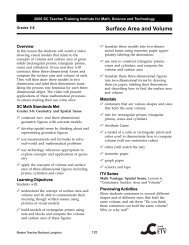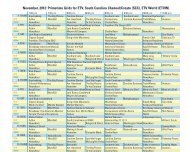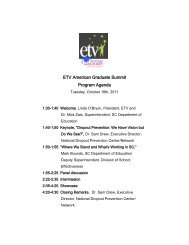official City of Conway Tree Protection - South Carolina ETV
official City of Conway Tree Protection - South Carolina ETV
official City of Conway Tree Protection - South Carolina ETV
Create successful ePaper yourself
Turn your PDF publications into a flip-book with our unique Google optimized e-Paper software.
Over the<br />
humblest <strong>of</strong> cottages<br />
and the grandest<br />
old homes,<br />
<strong>Conway</strong>’s magnificent<br />
live oaks<br />
spread their arms<br />
in benediction.<br />
The city’s history<br />
<strong>of</strong> protecting its trees<br />
dates to the 1780’s,<br />
and today,<br />
the city enforces a<br />
tree ordinance<br />
designed to protect its<br />
“Oldest Citizens”.<br />
<strong>City</strong> <strong>of</strong> <strong>Conway</strong><br />
Planning Department<br />
1001 Third Avenue<br />
P.O. Box 1075<br />
<strong>Conway</strong>, <strong>South</strong> <strong>Carolina</strong><br />
Phone: (843) 248-1760<br />
Fax: (843) 248-1769<br />
PROTECTING<br />
CONWAY’S<br />
OLDEST<br />
CITIZENS<br />
The <strong>City</strong> <strong>of</strong> <strong>Conway</strong>, SC<br />
<strong>Tree</strong> <strong>Protection</strong> Ordinance
Protecting <strong>Conway</strong>’s <strong>Tree</strong>s<br />
The preservation <strong>of</strong> trees and natural vegetation is deeply rooted in the history<br />
<strong>of</strong> <strong>Conway</strong> and is a critical public concern. The live oak trees which line many <strong>of</strong><br />
streets in <strong>Conway</strong> are probably the <strong>City</strong>’s most prized and protected natural<br />
resource. The city’s history <strong>of</strong> protecting its trees dates back to the 1780’s. Local<br />
legend has it that when the large oaks along Main Street were threatened by the<br />
construction <strong>of</strong> the railroad, Mrs. Mary Beaty appeared with a loaded shotgun and<br />
demanded that the construction workers “touch not a single bough”. The actions<br />
<strong>of</strong> Mrs. Mary Beaty have inspired the citizens <strong>of</strong> <strong>Conway</strong> to actively protect live<br />
oak trees and other indigenous tree species.<br />
The intent <strong>of</strong> the <strong>City</strong> <strong>of</strong> <strong>Conway</strong> <strong>Tree</strong> <strong>Protection</strong> Ordinance is to accomplish the following:<br />
A. To provide for the protection, preservation, proper maintenance and use <strong>of</strong><br />
trees and woodlands in order to minimize disturbance and to prevent damage<br />
from erosion and destruction <strong>of</strong> the natural habitat;<br />
B. To protect trees and woodlands for their economic support <strong>of</strong> local property values<br />
and for their natural beauty, wilderness character, or geological, ecological or<br />
historical significance; and<br />
C. To address the public concern for these natural resources in the interest <strong>of</strong><br />
health, safety and general welfare <strong>of</strong> the residents <strong>of</strong> this community.<br />
Designation <strong>of</strong> Protected <strong>Tree</strong>s and Landmark <strong>Tree</strong>s<br />
The <strong>Conway</strong> <strong>Tree</strong> <strong>Protection</strong> Ordinance classifies certain tree species as<br />
Protected <strong>Tree</strong>s and Landmark <strong>Tree</strong>s. The following trees shall be considered<br />
Protected <strong>Tree</strong>s:<br />
A. <strong>Tree</strong>s planted or retained to meet the <strong>City</strong> <strong>of</strong> <strong>Conway</strong> Landscape Regulations.<br />
B. All trees equal to or in excess <strong>of</strong> eight inches (8”) diameter at breast height<br />
(d.b.h.) located on any non-residential developed lot.<br />
C. American Holly 8” d.b.h.<br />
D. Flowering Dogwood 4” d.b.h.<br />
E. Redbud 4” d.b.h.<br />
F. Live Oaks 8” d.b.h.<br />
The following trees shall be considered Landmark <strong>Tree</strong>s:<br />
A. All live oak tree designated on the map entitled “The Oaks <strong>of</strong> <strong>Conway</strong>,<br />
<strong>South</strong> <strong>Carolina</strong>” researched and prepared by Joseph N. Pinson, Jr., Eugene<br />
Holbert and Evelyn Snider.<br />
B. Any live oak tree equal to or in excess <strong>of</strong> thirty inches (30”) d.b.h.<br />
C. Any tree designated by the <strong>City</strong> Council to be a Landmark <strong>Tree</strong>.<br />
Preservation <strong>of</strong> Protected <strong>Tree</strong>s and Landmark <strong>Tree</strong>s<br />
The removal or destruction <strong>of</strong> any protected tree or landmark tree located within<br />
the city limits <strong>of</strong> <strong>Conway</strong> without a tree removal permit shall be prohibited. No<br />
person shall intentionally damage or injure any protected tree or landmark tree.<br />
Criteria for Removal <strong>of</strong> Protected <strong>Tree</strong>s<br />
Requests to remove protected trees shall be reviewed on a case by case basis by<br />
the <strong>City</strong> Planner. Prior to the issuance <strong>of</strong> a tree removal permit for a protected tree,<br />
the <strong>City</strong> Planner shall determine one or more <strong>of</strong> the following conditions exists:<br />
A. The tree is hazardous;<br />
B. The tree is dead or dying;<br />
C. The tree is diseased or infectious as certified by a registered forester or certified<br />
arborist;<br />
D. The tree or its root system is causing visible damage to structures, areas used for<br />
pedestrian and vehicular traffic, or underground utility lines;<br />
E. <strong>Tree</strong>s within power line easements that cannot be properly pruned by the local<br />
utility company;<br />
F. <strong>Tree</strong>s, after proper pruning, which cause safety-related problems;<br />
G. The tree is located in the footprint <strong>of</strong> a proposed addition or expansion, and<br />
there is no practical alternative locations on the lot for the addition or expansion<br />
or practical means to build around the tree.<br />
H. <strong>Tree</strong>s, after proper pruning, which cause safety-related problems;<br />
I. The tree is located in the footprint <strong>of</strong> a proposed addition or expansion, and<br />
there is not practical alternative location on the lot for the expansion or practical<br />
means to build around the tree.<br />
Criteria for Removal <strong>of</strong> Landmark <strong>Tree</strong>s<br />
Requests to remove landmark trees shall be reviewed on a case by case basis by<br />
the Community Appearance Board (CAB). The CAB may authorize the <strong>City</strong><br />
Planner to issue a tree removal permit for the removal <strong>of</strong> a landmark tree provided<br />
the Board determines one or more <strong>of</strong> the following conditions exists:<br />
A. The tree is hazardous and in decline and cannot be properly pruned to alleviate<br />
such condition;<br />
B. The tree is diseased or infectious as certified by a registered forester or certified<br />
arborist and cannot be properly treated or pruned to alleviate such condition.<br />
C. The tree is located on a lot in such a position that the lot cannot be developed<br />
in a reasonable and prudent manner. In this instance, the CAB shall consider if<br />
a request for a variance from a particular zoning requirement would alleviate the<br />
need to remove such landmark tree; and if so determined, initiate such request with<br />
the Board <strong>of</strong> Zoning Appeals. In this instance, if no alternative to the removal<br />
<strong>of</strong> the landmark tree can be obtained, the CAB may attached any conditions to the permit<br />
the Board deems necessary to ensure compliance with the intent <strong>of</strong> this Ordinance.<br />
<strong>Tree</strong> Mitigation Policy<br />
In instances where the CAB approves the removal <strong>of</strong> a landmark tree, the Board<br />
may require the installation <strong>of</strong> new trees to compensate for the loss <strong>of</strong> the removed<br />
tree. The size, quantity, type and placement <strong>of</strong> such replacement trees shall be<br />
determined on a case by case basis by the CAB with consideration given to the<br />
prominence <strong>of</strong> the tree, the historic significance <strong>of</strong> the tree, the number <strong>of</strong> trees<br />
necessary to compensate for the aesthetic loss, and any other factors which the<br />
CAB believes is relevant in determining the number <strong>of</strong> replacement trees.<br />
<strong>Tree</strong> <strong>Protection</strong> During Construction<br />
During any type <strong>of</strong> development or construction, the following measures shall<br />
be utilized to protect any on-site tree that is not designated for removal.<br />
A. Protective barriers, such as silt fences, bollards, roping or other such devices as<br />
approved by the <strong>City</strong> Planner, shall be placed around each tree at the drip line<br />
<strong>of</strong> the canopy <strong>of</strong> each tree to prevent any type <strong>of</strong> encroachment under the<br />
drip line.<br />
B. Soil disturbance under the canopy <strong>of</strong> each tree shall be limited to six inches<br />
(6”) removed or six inches (6”) added. Soil compaction must be minimized.<br />
C. Trenching shall be no closer than six (6) times the diameter at breast height<br />
to the effected tree nor disrupt more than thirty percent (30%) <strong>of</strong> the drip<br />
line root area.<br />
D. No other types <strong>of</strong> disturbance or construction shall be allowed under the drip<br />
line <strong>of</strong> any tree without prior approval <strong>of</strong> the <strong>City</strong> Planner.<br />
<strong>Tree</strong> Pruning<br />
Maintenance pruning allows for the healthy uniform growth <strong>of</strong> a tree. <strong>Tree</strong> pruning<br />
shall promote the health and natural growth <strong>of</strong> the tree. Unnatural pruning techniques<br />
shall be prohibited. Examples <strong>of</strong> unnatural pruning are topping, stubbing, dehorning,<br />
or lopping. <strong>Tree</strong> pruning shall be accomplished in accordance with the procedures<br />
set forth in the 1995 ANSI A300 standards.<br />
Procedures for Obtaining <strong>Tree</strong> Removal Permit<br />
All requests for tree removal permits shall be submitted to the <strong>City</strong> Planner.<br />
A. Where such requests involve the removal <strong>of</strong> protected trees from developed lots,<br />
the applicant shall submit to the <strong>City</strong> Planner the appropriate documentation<br />
necessary to support the need for the removal <strong>of</strong> the protected tree. The<br />
<strong>City</strong> Planner may make an on-site inspection in order to verify the condition<br />
<strong>of</strong> the tree. If the <strong>City</strong> Planner determines that one or more <strong>of</strong> the criteria for<br />
removal <strong>of</strong> protected trees has been met, a tree removal permit shall be issued.<br />
B. Where such requests involve the removal <strong>of</strong> a landmark tree from any lot, the<br />
applicant shall submit to the Community Appearance Board the appropriate<br />
documentation necessary to support the need for the removal <strong>of</strong> the landmark<br />
tree. The CAB shall review the request and determine if the removal <strong>of</strong> the<br />
landmark tree is appropriate.<br />
C. Where such requests involve the removal <strong>of</strong> protected trees from undeveloped<br />
lots, the applicant shall submit a site plan <strong>of</strong> the proposed development to<br />
the <strong>City</strong> Planner. The <strong>City</strong> Planner or CAB shall have the authority to<br />
require the submittal <strong>of</strong> a tree survey for any undeveloped lot where the<br />
removal <strong>of</strong> the protected trees or landmark trees is proposed. Approval <strong>of</strong> the<br />
site plan by the <strong>City</strong> Planner or CAB and the issuance <strong>of</strong> a zoning permit for<br />
the project shall constitute permission to remove any trees not specifically<br />
noted to be preserved on the site plan.












